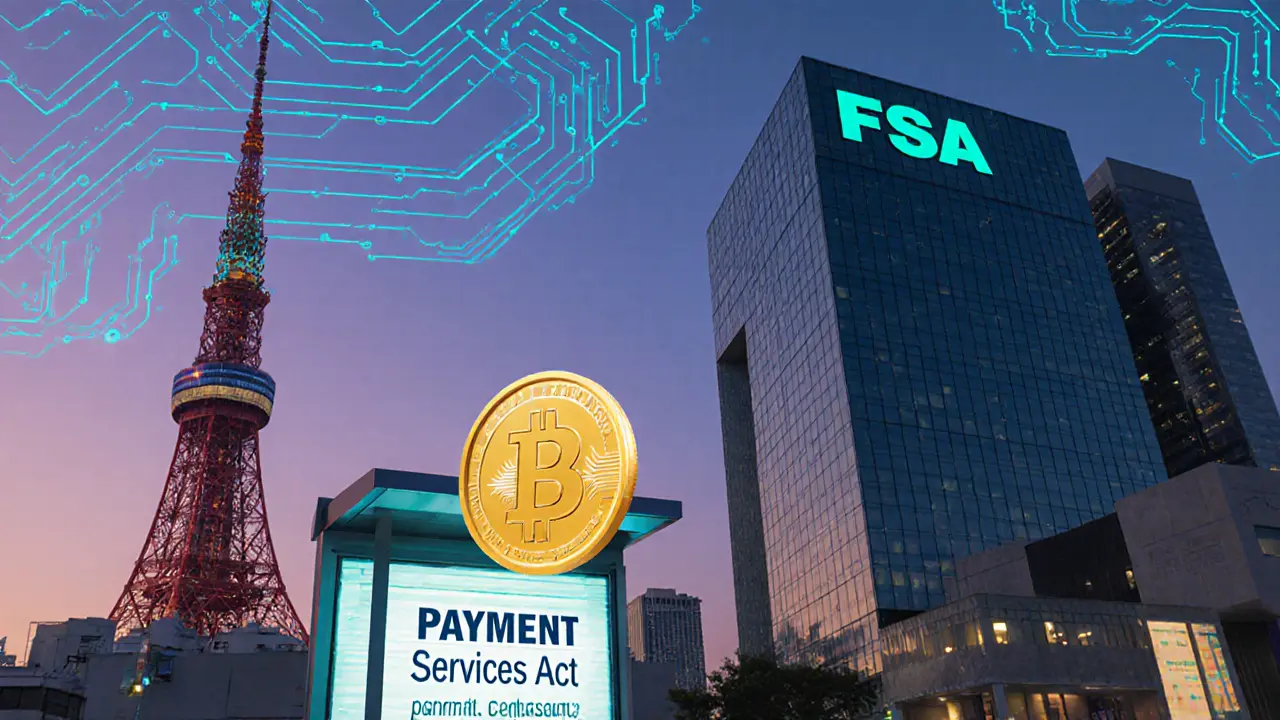Japan's Cryptocurrency Regulation Model: A Complete Guide

Japan Crypto Regulation Classifier
This tool helps determine whether your cryptocurrency project falls under Japan's Payment Services Act (PSA) or Financial Instruments and Exchange Act (FIEA) based on the criteria outlined in the article.
Project Information
Regulation Classification Result
Japan has built one of the world’s most detailed crypto‑regulatory systems, and the rules matter whether you’re a trader, a startup, or an institution eyeing the market. This guide pulls together everything you need to know - from the two‑tiered legal framework to the upcoming shift that could reshape the whole landscape.
Key Takeaways
- The Financial Services Agency (FSA is Japan’s financial watchdog that licenses and monitors crypto businesses.)
- The Payment Services Act (PSA) governs most exchanges today, demanding registration, capital reserves, AML/KYC and 95% cold‑storage of user funds.
- From mid‑2025 the Financial Instruments and Exchange Act (FIEA) will absorb crypto regulation, treating many tokens like securities.
- Compliance is intensive: physical presence in Japan, detailed business plans, and multilingual reporting are mandatory.
- High taxes (up to 55%) currently dampen retail enthusiasm, but a proposed flat 20% rate could boost adoption.
What Is the Japan Cryptocurrency Regulation Model?
In simple terms, Japan’s model is a two‑layer legal apparatus that blends consumer protection with investor‑level oversight. The first layer, the Payment Services Act, handles basic crypto‑asset activities - buying, selling, and wallet services. The second layer, the Financial Instruments and Exchange Act, steps in when a token shows investment‑like features such as dividends, governance rights, or high volatility.
The split reflects a pragmatic view: most retail users need safety nets (cold storage, segregation of funds), while sophisticated investors deserve securities‑level disclosure and market‑conduct rules. The FSA monitors both tracks, issuing licences, conducting audits, and publishing guidance in Japanese and, increasingly, English.
Layer1: The Payment Services Act (PSA)
First revised in 2017 and refreshed in 2020 and 2023, the PSA sets the baseline for any crypto‑asset exchange service provider (CAESP). Under the act, a CAESP must:
- Register with the FSA and keep a physical office in Japan.
- Maintain a minimum capital reserve (typically ¥50million for midsize firms).
- Implement robust Anti‑Money Laundering (AML) and Know Your Customer (KYC) procedures - the FSA publishes a checklist every quarter.
- Segregate client assets from operating funds and store at least 95% of crypto holdings in offline cold wallets.
- Submit monthly transaction reports and annual audit statements.
Compliance isn’t optional - non‑registered platforms are shut down within weeks, and fines can reach ¥10billion. The system has already forced several offshore exchanges out of the market, consolidating the user base around domestically licensed firms.
Layer2: The Financial Instruments and Exchange Act (FIEA)
Originally designed for stocks, bonds, and derivatives, the FIEA has been extended to digital assets that function like securities. A token is pulled under FIEA when it meets any of the following criteria:
- Offers profit‑sharing, dividends, or revenue‑share rights.
- Provides governance influence that can affect the issuing project’s direction.
- Is marketed primarily as an investment vehicle rather than a payment method.
When the FIEA applies, issuers must file a prospectus, disclose material risks, and adhere to insider‑trading rules. The upcoming 2026 bill will also mandate regular reporting for crypto‑ETF providers, opening the door for spot‑Bitcoin products that meet the same standards as traditional ETFs.

PSA vs. FIEA: Quick Comparison
| Aspect | Payment Services Act (PSA) | Financial Instruments and Exchange Act (FIEA) |
|---|---|---|
| Primary focus | Payment‑type crypto‑assets and exchange services | Investment‑type tokens and market conduct |
| Licensing body | FSA crypto‑exchange licence | FSA securities licence (similar to stock brokers) |
| Capital requirement | ¥50million minimum (varies by size) | ¥100million minimum plus surplus to cover market‑risk exposure |
| Fund segregation | 95% offline cold storage | Same cold‑storage rule plus escrow accounts for securities‑type tokens |
| Disclosure obligations | Basic AML/KYC reports | Prospectus, periodic financial statements, insider‑trading monitoring |
| Applicable tokens (2025) | Bitcoin, Ether, stablecoins, utility tokens | Security‑like tokens, tokenised equity, crypto‑ETFs |
Compliance Checklist for Crypto Businesses
If you’re planning to launch a crypto service in Japan, here’s a practical roadmap. Each step aligns with either the PSA or the forthcoming FIEA regime.
- Establish a Japanese legal entity - a Kabushiki Kaisha (KK) or Godo Kaisha (GK) with a registered office.
- Prepare a detailed business plan - include market analysis, technology stack, AML/KYC workflows, and financial projections.
- Secure capital - meet the minimum reserve (¥50million for PSA, ¥100million for FIEA) and maintain a buffer for audits.
- Develop AML/KYC systems - integrate Japan’s My Number verification, sanction‑list screening, and transaction monitoring.
- Document the process in Japanese; the FSA reviews the manual during licensing.
- Implement cold‑storage architecture - keep at least 95% of user crypto in hardware wallets offline; retain a 5% hot‑wallet for withdrawals.
- File the registration application - submit via the FSA portal, attach the AML/KYC policy, risk‑management plan, and proof of capital.
- Undergo a pre‑license audit - the FSA may request on‑site inspections; be ready to show segregation accounts and wallet logs.
- Plan for FIEA transition - if your token has investment characteristics, prepare a prospectus draft and set up a compliance team for insider‑trading monitoring.
Typical timelines range from six to twelve months, depending on the completeness of documentation and the speed of capital infusion.
Upcoming Shift: PSA→FIEA Integration
On 2September2025 the FSA announced a roadmap to fold most crypto regulation under the FIEA. The move aims to close gaps where tokens behave like securities but escape PSA oversight. Key implications include:
- Mandatory disclosures for token issuers - prospectus, risk warnings, and periodic financial reports.
- Insider‑trading rules - anyone with material non‑public information about a token must refrain from trading, mirroring stock‑market standards.
- Market‑conduct rules - prohibitions on wash‑trading, market‑making without registration, and deceptive advertising.
- Pathway for regulated crypto ETFs - approved providers can launch spot‑Bitcoin or Ether ETFs after satisfying FIEA criteria.
The bill is slated for early 2026. Existing PSA‑licensed exchanges will need to amend their licences, update AML/KYC processes to cover securities‑type reporting, and possibly raise additional capital.
Tax Landscape: From 55% to Potential 20%
One of the biggest pain points for Japanese crypto investors is the steep tax rate - capital gains can be taxed as high as 55% when combined with income tax and inhabitant tax. The government is reviewing a reform that would cap crypto taxation at a flat 20% and allow loss carry‑forwards for three years. If enacted, the change could spur a wave of retail participation and attract foreign institutional funds that currently shy away from the tax burden.
Until the reform passes, businesses should provide users with annual tax‑reporting statements that break down gains, losses, and the applicable tax brackets. Automation tools that integrate with Japan’s National Tax Agency portal are gaining popularity among exchanges.

Market Size and User Behaviour
As of 2025, Japan hosts over 12million exchange accounts and more than ¥5trillion (≈$33.7billion) in crypto deposits. Yet, only about 12% of residents have ever owned Bitcoin. The typical user is a middle‑income earner who views crypto as a long‑term store of value rather than a day‑trading instrument.
Community sentiment is mixed: on Reddit and domestic forums, users praise the FSA’s transparency and the mandatory cold‑storage rule, but they also grumble about the tax squeeze and the paperwork needed to stay compliant. Some investors are relocating to tax‑friendlier hubs such as Singapore or the UAE, a trend that could affect Japan’s future market share.
How Japan Stacks Up Against Other Jurisdictions
Compared to the United States, where federal and state regulators still argue over which agency has jurisdiction, Japan offers a single, clearly‑defined licensing process. China, by contrast, bans crypto trading and mining outright, eliminating any legal pathway for businesses. The European Union’s MiCA regulation, while comprehensive, spreads requirements across member states and often leaves room for interpretation.
Singapore’s approach is less centralized - the Monetary Authority of Singapore (MAS) regulates through a fintech‑friendly sandbox, but different types of tokens fall under separate regimes, creating a patchwork similar to the U.S. Japan’s dual‑layer model is arguably more streamlined, even if the upcoming FIEA integration adds a layer of complexity for security‑type tokens.
One advantage Japan still lags on is taxation: countries like Germany exempt crypto gains after one year of holding, making them more attractive for long‑term investors. The pending tax reform could close that gap, but the current 55% ceiling remains a deterrent.
Practical Steps for Companies Wanting to Enter Japan
- Partner with a local law firm - navigating the PSA/FIEA paperwork is far easier with native‑language expertise.
- Hire a Japanese compliance officer - this role handles AML/KYC, cold‑storage verification, and liaison with the FSA.
- Localise your platform - Japanese UI/UX, support in Japanese, and integration with national ID (My Number) for verification.
- Prepare for audits - set up immutable logs for wallet movements and separate accounts for client funds.
- Plan for future FIEA requirements - if your token could be deemed a security, draft a prospectus now and monitor the 2026 bill’s progress.
- Consider tax‑efficient structuring - evaluate whether a subsidiary or a joint‑venture can mitigate the 55% tax exposure.
Following this checklist can shave months off the licensing timeline and reduce the risk of costly enforcement actions.
Future Outlook
Analysts expect Japan’s regulatory stability to keep attracting institutional capital, especially once crypto ETFs receive FIEA approval. The country’s early adoption of clear rules has already built a robust ecosystem of domestic exchanges, custodians, and DeFi research groups. The FSA’s DeFi Study Group, meeting every two to three months, is a sign that the regulator is staying ahead of emerging trends.
However, success hinges on balancing protection with innovation. If the FIEA transition becomes overly burdensome, startups may look to friendlier jurisdictions, eroding Japan’s market share. Conversely, a well‑executed reform could cement Japan’s reputation as the global benchmark for crypto regulation.
Frequently Asked Questions
What is the difference between PSA and FIEA for crypto?
The PSA covers payment‑type crypto activities - exchanges, wallet services, and utility tokens. The FIEA applies when a token looks like a security, requiring prospectuses, insider‑trading rules, and higher capital reserves.
Do I need a physical office in Japan to get a crypto licence?
Yes. The FSA requires every CAESP to register a local entity with a staffed office. Remote‑only setups are not accepted.
How much capital must I hold for a PSA licence?
The baseline is ¥50million (about $350,000). Larger exchanges or those handling securities‑type tokens under FIEA need at least ¥100million.
Will the upcoming FIEA changes affect existing PSA‑licensed exchanges?
Existing PSA licences can continue, but any token classified as a security will require a separate FIEA licence and associated disclosures. Most exchanges are preparing dual‑licence structures.
Is crypto tax in Japan really that high?
At present, gains are taxed as ordinary income, topping out around 55% for high earners. A proposed reform could lower the rate to a flat 20% and allow loss carry‑forwards, but it’s not yet law.

Rama Julianto
October 13, 2025 AT 00:51Yo, if you think Japan's crypto rules are just some fluffy paperwork, you're dead wrong – they actually bite hard. The PSA might sound like a simple registration, but you gotta keep ¥50 million locked up, and the FSA will hunt you down for any slip‑up. Cold‑storage? Yeah, 95% of user funds must sit in offline vaults, not some hot‑wallet you forget to secure. And don’t even get me started on the AML/KYC grind – you’ll be filling out forms faster than a tax accountant on deadline. Miss a My Number verification and the regulator will slap you with a fine that makes your head spin. The capital reserve isn’t just a suggestion; it’s a hard bar that keeps the small fry out. If you’re planning a security‑type token, brace yourself for the FIEA nightmare: prospectus filing, insider‑trading rules, and a ¥100 million minimum capital. That’s not a joke, that’s a wall of cash you need before you even think about launching. The upcoming 2025 shift will drag most PSA‑only outfits into the FIEA maze, so start building compliance teams now or get crushed later. Tax rates up to 55%? Yeah, that’ll chew up any profit unless the flat‑20% reform passes, which is still up in the air. In short, Japan isn’t a playground – it’s a battlefield where only the well‑funded survive.
Helen Fitzgerald
October 14, 2025 AT 07:24Hey everyone, just wanted to add a quick note for anyone feeling overwhelmed – the key is to break it down step by step. First, set up a solid Japanese legal entity; a KK or GK with a real office will get you past the biggest hurdle. Then, lock in the required capital – think of it as your safety net. Once that’s sorted, focus on AML/KYC; the FSA actually provides a handy checklist you can follow. And don’t forget the cold‑storage rule – 95% offline is a must, but you can use reputable custodians to make it easier. If you’re dealing with a token that looks like a security, start drafting a prospectus early – it’ll save you a ton of back‑and‑forth later. Keep an eye on the upcoming FIEA integration; staying ahead of that news will keep you from surprise compliance jolts. Lastly, consider using a local compliance partner – they can translate the regulatory language and keep you on track. You’ve got this!
Jon Asher
October 15, 2025 AT 13:57Totally agree with the step‑by‑step approach, especially the part about nailing the AML/KYC checklist first. It’s easy to get lost in the capital numbers, but without clean customer verification the FSA will flag you fast.
Scott Hall
October 16, 2025 AT 20:31Good point about the custodians – I’ve seen a few firms in Japan that specialize in 95% cold‑storage solutions and they really simplify the technical side. Pair that with a local compliance buddy and the process feels much smoother.
Jade Hibbert
October 18, 2025 AT 03:04Sure, because writing a prospectus is sooo much fun.
Leynda Jeane Erwin
October 19, 2025 AT 09:37From a legal perspective, the distinction between PSA‑registered activities and FIEA‑subject securities is pivotal. While PSA focuses on payment services, the FIEA imposes securities‑law obligations, including prospectus disclosure and insider‑trading prohibitions. Entities should therefore conduct a classification analysis early to determine the appropriate licensing pathway.
Brandon Salemi
October 20, 2025 AT 16:11Quick tip: draft a simple prospectus template now – even a rough version helps you spot gaps early and speeds up the FIEA application later.
Siddharth Murugesan
October 21, 2025 AT 22:44Honestly, all this regulatory hype just scares away innovative projects. The barriers are too high; if you’re not a big player, you’ll never get a foothold.
Hanna Regehr
October 23, 2025 AT 05:17Don’t let the barriers discourage you – many startups have successfully navigated Japan’s system by partnering with local firms. Leveraging their expertise can turn those obstacles into manageable steps.
Ben Parker
October 24, 2025 AT 11:51💡 Pro tip: Use a reputable Japanese custodian for cold storage – they handle the 95% offline requirement so you can focus on building your product. 🚀
Daron Stenvold
October 25, 2025 AT 18:24Looking ahead, the integration of PSA into FIEA by 2025 promises a more unified regulatory environment. This could streamline licensing but will also impose stricter controls on token issuers, especially regarding disclosure and market conduct.
hrishchika Kumar
October 26, 2025 AT 23:57From a cultural standpoint, Japan’s focus on consumer protection resonates with its broader societal values of safety and trust. This ethos shapes the regulatory landscape, making compliance not just a legal hurdle but an expectation of responsibility.
Nina Hall
October 28, 2025 AT 06:31Stay positive! Even with high taxes, the potential for institutional inflows after the crypto‑ETF approvals could offset the costs and bring massive liquidity to the market.
Lena Vega
October 29, 2025 AT 13:04Clear compliance steps = smoother launch.
Mureil Stueber
October 30, 2025 AT 19:37Overall, the Japanese model offers a solid framework for both payment services and security‑type tokens. By planning ahead, partnering locally, and staying informed on regulatory updates, businesses can successfully enter this market.